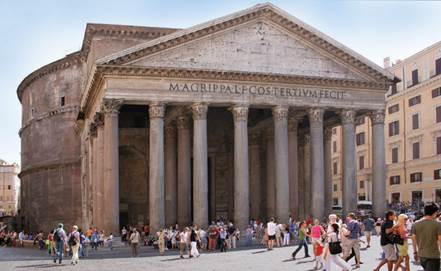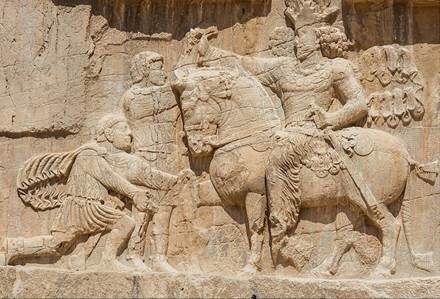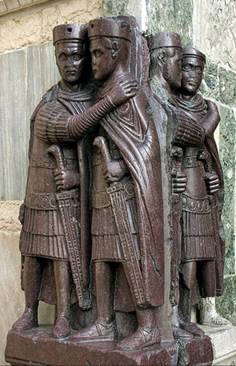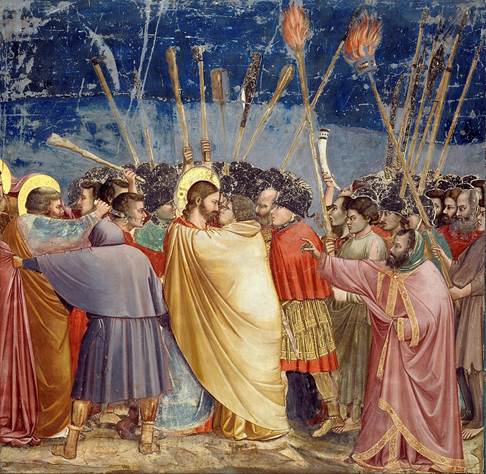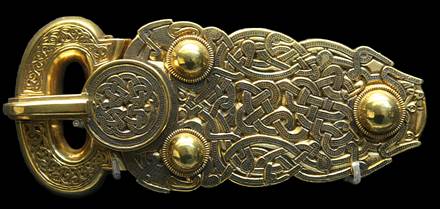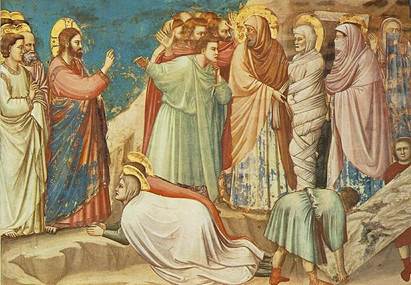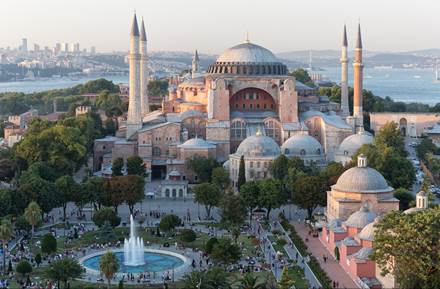Despite losing its democratic character, the Roman Empire became a tremendous success, known for its world class army, its far-reaching trading network, high-quality mass-produced goods, and its marvelous architecture. Yet even the empire would eventually collapse. The western part of the empire fell when Germanic barbarians invaded and took over, plunging much of Europe back to prehistoric standards of living.
Emperor Augustus
When Octavian became the first emperor of Rome, he was determined not to fall into the same trap that had led to Caesar’s assassination. Caesar had presented himself as a dictator and disrespected the Senate, which made him many enemies. Instead, Octavian pretended his goal was to restore the republic to its former glory. He made it appear that the republic functioned as usual, while in reality he came to wield most of the power behind the scenes. For instance, he continued to allow elections for most governmental offices, but he kept the position of consul for himself and his general Marcus Agrippa. The tribune also continued to exist, but only with a fraction of its former power. In what seems to have been a staged performance, Octavian was asked by the Senate to stay in charge of a couple of provinces. It wasn’t a coincidence that these provinces contained the vast majority of the army.
Octavian also went to great lengths to avoid presenting himself as a monarch. Instead of crowning himself emperor, he had the Senate pick a number of titles for him with republican precedents. None of these titles by themselves would seem dictatorial, but combined, they gave him the prestige reminiscent of an emperor. For instance, the title Augustus (meaning “venerable”) depicted Octavian as a devout man willing to respect the gods, but, at the same time, presented him as deserving of veneration. The title Princeps Civitatis (meaning “first citizen”) cleverly presented him as an ordinary law-abiding citizen while simultaneously emphasizing his elevated status. The title Pater Patriae (meaning “father of the country”) depicted him as a loving and protective father of his people, but it also conveyed the respect and the strong authoritarian role of the father in Roman families (the pater familias). Finally, he was granted the title imperator (derived from the word “to command”), which presented him as a military leader. Ironically, the word became the root of the English word “emperor.”
Fig. 330 – Statue of Octavian (Augustus) by an unknown sculptor (1st century AD) (Till Niermann, CC BY-SA 3.0; Vatican Museum)
Augustus also adopted a relatively simple lifestyle to avoid royal connotations. Rather than living in a large palace, he lived in a house of modest size. He also dressed in a simple citizen’s toga and ate simple foods.
To help solidify his rule, Augustus ordered the poet Virgil (70–19 BC) to write him an epic poem. In this poem, Virgil presented a history of Rome from the early days, linking Augustus all the way back to the founding of Rome and to the Greek hero Aeneas and his goddess-mother Aphrodite. All these strategies combined seem to have worked out, for Augustus died of natural causes after an impressive 40 years of rule.
But Augustus’s rule had one major flaw that would keep plaguing Rome and would eventually contribute to its downfall. Instead of selecting the most capable man as his successor, he appointed a biological heir. Augustus had a few capable family members in mind, but they all died prematurely. Eventually the only remaining option even remotely connected to Augustus was the son of his wife Livia from a previous marriage, named Tiberius (42 BC–37 AD). Tiberius was part of the Claudian family, rather than the Julian. He also is said to have had a rather unpleasant character. Nevertheless, the empire ran fairly efficiently under his rule, and because of his miserliness, the treasury ended up with a large surplus. To lead the troops, Tiberius relied heavily on his more popular son Germanicus (15 BC–19 AD).
The problems started when Tiberius was succeeded by Caligula (12–41 AD), son of Germanicus. Due to his father’s popularity, Caligula was at first greeted with enormous enthusiasm. Over the first few months, he did much to please both the people and the Senate, but after contracting some form of brain fever, he became an insane tyrant, killing many members of his family and the political class, sometimes for mere amusement. He also plunged the empire into debt by organizing huge spectacles for the people and indulging in his own extravagant lifestyle. Various sources also accuse Caligula of sexual perversion, including incest with his sisters and turning his palace into a brothel. We also read that he demanded to be worshiped as a god. He dressed up as his favorite gods, spoke to them as equals, and had temples built where people could worship him. On top of all this, Caligula is said to have appointed his horse to the post of consul.
Eventually the praetorian guard, the bodyguards of the emperor, could no longer tolerate his behavior and stabbed him to death. They then elected Claudius (10 BC–54 AD), the 51-year-old uncle of Caligula and brother of Germanicus. This appointment was exceptional since Claudius suffered from many disabilities, including a speech impediment. He did, however, have a sharp mind. He even wrote several books on history, which are now, unfortunately, lost. It is said he also used his disabilities to appear like a fool to avoid Caligula’s murder sprees. Despite his lack of experience in politics, Claudius proved to be an able and efficient administrator, restoring the empire’s finances and constructing many new roads, aqueducts, and canals across the empire. During his reign, the empire also began the conquest of Britain. In 54 AD, after reigning for almost 14 years, Claudius was poisoned, and the position of emperor went to Nero (37–68 AD), who was only 16 years old at the time. At first, his rule was kept in check by his mother and by the famous Stoic philosopher Seneca (c. 4 BC–65 AD), but he eventually had them both killed, revealing himself as another insane tyrant. Nero killed politicians and also murdered almost every member of his family. He also mistakenly considered himself to be a great actor, musician, and charioteer. With no one daring to tell him the truth, he collected hundreds of prizes on a tour of Greece. Nero also began a trend among Roman emperors to debase the coinage by adding cheaper metals to them, leading to massive inflation. While the silver content of coins had originally been 94%, two centuries later, it was reduced to only 0.02%, collapsing the economy.
In 64 AD, a devastating fire burned down ten out of Rome’s fourteen districts. Displaying an astonishing level of insensitivity, Nero then used an area cleared out by the fire to erect a lavish new palace for himself, known as the Domus Aurea (“Golden House”). The palace became such an embarrassment that later emperors decided to build right over it. According to the senator and historian Tacitus (c. 56–120 AD), Nero blamed the devastation of the fire on the Christian community, initiating the empire’s first persecution of Christians. Eventually both the Senate and the generals rose up against him. He finally committed suicide to avoid capture.
Having killed off all his relatives, there was no obvious heir. As a result, a civil war broke out over the throne of Rome. Within the short span of 18 months, Rome counted four emperors, until the last one, Vespasian (9–79 AD), brought back stability. During his reign, the Colosseum was built.
When Vespasian died, power passed on to his son Titus (39–81 AD) and then to his grandson Domitian (51–96 AD), who was another mad emperor. When Domitian was assassinated, the Senate quickly nominated Nerva (30–98 AD), who was boring and old but a safe choice. Nerva also did the right thing by carefully choosing a competent successor, Trajan (53–117 AD), who had a long and successful career both as a military man and an administrator. On top of this, Trajan was popular with the people and was polite to the Senate. Nerva adopted him as his son to make the transition of power legitimate. Trajan became part of a succession of five good emperors, who began an era of unprecedented peace, security, and prosperity for Rome.
The concrete revolution
Rome specialized in the use of concrete, which allowed them to build constructions with greater ease and in a much greater variety of shapes, as concrete can easily be poured into wooden molds of arbitrary shape. The Romans also mastered the use of the arch, the vault, and the dome. Trajan’s successor, Hadrian (76–138 AD), ordered the building of the Pantheon, which combined these elements. The building, seen in Fig. 331 and Fig. 332, became one of the most influential buildings of all time. In front of a magnificent dome, we find a square façade with a triangular pediment. This combination of dome and façade has inspired many government buildings in the modern age, including the US Capitol building in Washington.
Fig. 331 – The Pantheon in Rome (126 AD) (© Adobe Stock)
Fig. 332 – The Pantheon in Rome (126 AD) (Roberta Dragan, CC BY-SA 2.5)
The crisis of the third century
The last of the five good emperors was the philosopher-emperor Marcus Aurelius (121–180 AD), who was also a serious contributor to the Stoic school of philosophy (which we will discuss in the next chapter). Despite his brilliance, Marcus Aurelius made one crucial mistake. Since the other good emperors had no children of their own, they adopted their heirs based on merit. Marcus, however, reverted to the old tradition of choosing his biological son, Commodus (161–192 AD). Marcus had done his best to educate his son and even shared power with him when he was only sixteen. Despite all this training, however, Commodus turned into another mad emperor. He mocked and murdered senators and was notoriously lazy, delegating most of his political work to others. Despite his behavior, however, he managed to rule for twelve years before he was assassinated.
In 193, the Praetorian Guard announced it would offer the throne to whoever was willing to pay them the most money. They elected Didius Julianus (133–193 AD), who was murdered after only 66 days. After his assassination, three legions in the empire acclaimed their own commander as emperor, leading to a civil war. The winner was Severus (145–211 AD), the first of the so-called soldier emperors, who seized power through their command of the army.
In 218 AD, Elagabalus (c. 204–222 AD) became emperor at the age of fourteen. He had little interest in government, married six wives, and supposedly enjoyed giving his staff bizarre orders, such as bringing him a thousand pounds of spider webs or a thousand weasels. He is also said to have released poisonous snakes into the audience at the Circus Maximus for his own amusement and let himself be carried around the city in a chariot pulled by either lions or naked women. Elagabalus also further debased the coinage, leading to such a terrible burst of inflation that it significantly reduced people’s trust in the currency. He was finally killed, after which his body was dragged through the streets on a hook, thrust into a sewer, and flung into the Tiber.
As the third century progressed, the empire became more and more unstable, which historians refer to as the crisis of the third century. The barbarian invasions intensified, civil wars broke out, entire chunks of the empire broke away, the plague broke out, and the economy was further damaged by the debasement of currency. The year 238 even counted as many as seven different emperors, and the 50 years that followed counted at least 26 official emperors. On various occasions, two or more military leaders proclaimed themselves emperor simultaneously, leading to civil war. These internal fights, in turn, left the border weak, which gave the barbarians the upper hand. This cycle exhausted the Roman army. At the same time, local rulers at the edges of the empire saw their chance to break off and form their own states. In 260, Rome experienced an especially shameful moment when Emperor Valerian (c. 195–265 AD) was captured by the Persians, who held him prisoner for the remainder of his life (see Fig. 333). An early Christian source tells us that Valerian was being used by the Persian king as a human footstool to help him mount his horse.
But then, around 270, a series of military emperors managed to stabilize the empire and grant it another 100 years of life. Emperor Aurelian (c. 214–275 AD) even managed to gain back much of the territory that had been lost, giving him the title “Restorer of the World.” However, he was not able to fix the persisting economic problems. During his term, prices rose by a factor of eight. To promote the unity of the empire, he made the cult of the sun god Sol Invictus (“Unconquered Sun”) the official cult of the empire, foreshadowing the later adoption of the Christian God by Emperor Constantine.
Fig. 333 – The Persian king Shapur I capturing Emperor Valerian (standing before the horse) (Diego Delso, Delse.photo, CC BY-SA 3.0)
Fig. 334 – The Tetrarchs (4th century). Notice the simplistic and generalized depiction of the four rulers. Art was clearly on the decline. (Nino Barbieri, CC BY-SA 3.0)
Emperor Diocletian (244–311 AD) was the first to realize that the empire had become too big to rule by one man, and therefore, he split the empire into an eastern and a western half. He placed himself in charge of the east while letting his general Maximian (250–310 AD) rule the west as co-emperor. Together they had firm control over the empire for 20 years. Eventually they added two junior emperors, called Caesars, who would replace the emperors when they retired. Together they formed the Tetrarchy (“Rule of Four,” see Fig. 334). Diocletian also cleverly split the provinces that contained large sections of the army, reducing the possibility for a governor to stage a rebellion and he also introduced a new coin with a guaranteed gold content. He did make the mistake of issuing wage and price controls, which discouraged trade. Eventually he voluntarily stepped down from his position as emperor.
After Diocletian’s retirement, the popular general Constantine (c. 272–337) was proclaimed emperor by the British troops and defeated the tetrarchy in a civil war. The night before the battle, in 312, he unexpectedly converted to Christianity, which is the subject of a later chapter. Constantine also created an eastern capital of the empire by rebuilding the old Greek colony of Byzantium and renaming it Constantinople (now called Istanbul). Wanting his city to function as a second Rome, he ordered the construction of a grand palace, an amphitheater, a stadium for chariot racing, a Senate, and libraries.
The barbarian invasions
Rome had been fighting several “barbarian” tribes at its border since the early days of the Republic. They were mostly Celtic and Germanic nomadic warrior tribes from Europe. The term “barbarians” came from the Greeks, who believed their speech sounded like “bar bar.” The Greeks and Romans described them as aggressive and uncivilized. They fought naked and put paste in their hair to make it stand on end, giving them an especially intimidating look. They were also known to be excellent metalsmiths and regularly wore golden neckbands (see Fig. 335)
The Romans also had a few advantages over the barbarians. They had a professionally trained army, they mass-produced high-quality weapons, and they had the infrastructure and logistical organization to supply their army. However, while all fighting-age barbarian males were expected to fight, only part of the Roman population was enlisted in the army, causing them to be greatly outnumbered. The barbarians also had the advantage of being taller than their Roman adversaries.
The relationship between the tribes and Rome was complex. The tribes often fought amongst themselves, and the Romans also frequently allied with various tribes in opposition to others. In some cases, the barbarians were even invited within the borders of the empire in exchange for military service. Fortunately for the Romans, the barbarians weren’t unified and weren’t ideologically opposed to them. In fact, starting in the fourth century, various tribes even converted to Christianity and adopted various Roman customs.
Fig. 335 – Roman copy of a Greek sculpture named the Dying Galatian (c. 330 BC) The Galatians were a Celtic tribe that ended up all the way in Turkey. Notice the characteristic Celtic golden neckband, hairstyle, and mustache. (Antmoose, CC BY 2.0; Capitoline Museum)
In the early days of Rome, the main threat came from the Celts of Northern Italy. In c. 390 BC, one of these tribes even managed to sack Rome. It took the Romans until 225 BC to defeat these tribes, who, in time, became thoroughly Romanized. The Celts in Gaul (France) took a lot longer. They were finally subdued in 50 BC by Julius Caesar, who wrote about his many ruthless battles against them in his Commentaries on the Gallic War. Eventually Gaul, too, became Romanized.
In 55 BC, Caesar invaded Britain, with some initial success, but he eventually left. About a century later, in 43 AD, Emperor Claudius ordered another invasion, but this time, the intention was to stay. The Romans established several strongholds for their legions, including Londinium, which later became London. They managed to conquer England but didn’t manage to take Scotland. To defend themselves from the Scottish tribes, Emperor Hadrian marked the northern border of the Empire by building Hadrian’s Wall in the early second century.
Fig. 336 – A Roman thermal bath in the English city of Bath (c. 75 AD) (Diego Delsa, CC BY-SA 4.0)
Near the end of the Empire, Germanic tribes, such as the Goths and the Franks, became the major threat to Rome. In the late fourth century, they attacked in record numbers, which gradually shifted the power in favor of the barbarians. Around this time, the Huns—with their reputation for being the fiercest tribe—also appeared, coming in from the Central Asian steppes. When they invaded the territory of the Goths, the Goths sent a request to Emperor Valens (c. 328–378 AD) seeking permission to take refuge within Roman territory. Valens agreed and also offered them food in exchange for military service and conversion to Christianity. However, local officials cheated the Goths by failing to deliver the promised goods. As a result, the Goths turned against the Romans, resulting in the Battle of Adrianople in 378 AD. The Goths were victorious and even managed to kill Emperor Valens. To have a Roman emperor fall to a barbarian tribe was a symbolic blow to the stability of the empire.
In line with the multicultural attitude of the Romans, it was also common for barbarians to serve in the Roman army. For instance, Stilicho (c. 359–408 AD), son of a Roman mother and a Vandal father, served as an officer in the Roman army. The Frankish general Arbogast (d. 394 AD) even managed to become the most dominant figure in the Western Roman Empire. He was smart enough not to crown himself emperor. Instead, he put forward a Roman man named Eugenius (d. 394), whom he instructed behind the scenes. But when they contemplated reviving paganism, Emperor Theodosius (347–395 AD) of the Eastern Empire stepped in, defeated Eugenius in battle, and officially banned pagan worship.
More painful was the case of the Visigoth Alaric (c. 370–410 AD). Alaric had served in the Roman army, fighting for Theodosius against Arbogast. He then turned against the Romans and looted a number of cities, after which he was bought off with huge cash bribes. Later he was appointed general of the Roman forces in the Roman province Illyricum, but then he invaded Italy and threatened to attack Rome, after which he was bought off once more with money and titles. Finally, he actually captured and looted Rome for three days. In 455, the Vandals, under King Gaiseric (428–477 AD), captured Rome once more, sacking it much more thoroughly.
In the 450s, the Huns unified under Attila the Hun (c. 406–453 AD) and thereby became a threat to all of Europe. To defend themselves, the Western Roman Empire teamed up with several barbarian tribes and challenged Attila on the battlefield. The fight ended in a draw. The next year, Attila went straight for Rome. Pope Leo I (d. 461) managed to meet with Attila. Nobody knows what was said, but afterward Atilla decided to retreat. Fortunately for Rome, Attila died in 453, after which the Huns broke up into their separate tribes.
As the empire weakened, numerous barbarian tribes migrated into Roman provinces and carved them off from the empire, establishing their own kingdoms. The Britons and the Anglo-Saxons took England, the Visigoths took Spain, and the Franks eventually took Gaul and named it Francia. The final blow to the Western Empire came in 476, when Emperor Romulus Augustulus (c. 460–476 AD) was deposed by yet another barbarian serving in the Roman army, Odoacer (c. 433–493 AD), who declared himself king of Italy.
The decline of Europe
The fall of the Western Empire in the fifth century led to a severe decline in living standards that lasted for centuries. In many ways, it returned the population to a quality of life typical of prehistoric times. Cities dramatically shrank in size. Rome, which had once housed a million people, declined in the Middle Ages to a population of just 17,000 people. It would take until 19th-century London for another city to reach a million citizens. Paved streets, aqueducts, public baths, and floor heating disappeared. Tiled roofs, which had been common in Rome even for small animal sheds, disappeared as well, only to reappear in Late Medieval Italy. Even stone buildings disappeared in many places, even for the aristocracy, who turned to wood instead. In Italy, where an unbroken tradition of stone buildings did continue, monumental buildings considerably declined in size. Marble and mosaic floors were now reserved for palaces and churches, while the rest had to contend with simple beaten earth.
The mass production of high-quality goods also vanished, as did Rome’s complex and far-reaching trade network. In Roman times, many people owned at least a couple of luxury products made far from home. To illustrate the scale of Roman trade, there still exists a hill in Rome about 50 meters high made up entirely of about 50 million broken amphorae. These pots were of high quality and were used to import oil into the city, where they were discarded upon delivery. After the fall of Rome, the distribution of goods became local, except for rare luxury goods for the upper classes. Even coinage disappeared almost entirely.
Art also came close to a standstill. Portraits generally lost their individualistic features and transitioned to idealized stereotypes. True portraits only reappeared in the Late Middle Ages. Intellectual pursuits, such as philosophy, mathematics, and science, also greatly declined. Literacy rates also dropped significantly. Although only a minority of the Roman Empire had been literate, writing had been common enough to be used for advertisement and in the form of casual graffiti.
In Britain, the decline was especially steep since the Roman presence in Britain had been short. When the Roman soldiers left in 410 AD, the Anglo-Saxons invaded the island and changed its name from Britain to England (“Land of the Angles”). Under Anglo-Saxon rule, Christianity disappeared, Roman towns and villas were abandoned, and even the pottery wheel disappeared for 300 years. Some impressive and sophisticated craftsmanship did remain, such as the Sutton Hoo jewelry (see Fig. 337), but only for the ruling class.
Fig. 337 – Anglo-Saxon jewelry from Sutton Hoo (c. 7th century AD) (Michel Wal, CC BY-SA 2.5; Rob Roy, CC BY-SA 2.5; British Museum)
The fall of Rome
Many hypotheses have been proposed to explain the fall of Rome. Obvious contributors are the increased invasions of the barbarians combined with economic malpractice and the endless civil wars for the throne of the empire. Also, because of its enormous size, Rome required an enormous army, which became very costly, putting even further strain on the economy. Once vulnerable, natural disasters and crop failures also came to have a more devastating impact. Additionally, the land had also become less fertile because of climate change. From the third century BC to the mid-second century AD, the climate of Rome was unusually warm, wet, and stable. After this period, temperatures cooled, and agricultural yield decreased as a result.
Over the centuries, the Roman army had provided security, but as Rome weakened, it could no longer defend the outskirts of the empire. Having relied on a professional army for centuries, the people in these areas had to relearn to defend themselves. This took considerable time, making them vulnerable to the barbarian warrior cultures. Many of the cities in these areas didn’t even have city walls, something that would be unheard of for centuries to come. The loss of security also greatly disturbed trade as traders ran the risk of being raided on their journeys. With Rome no longer coming to their aid, while still asking for taxes, it became tempting for various local leaders to opt out of the empire altogether. Salvianus (5th century), a monk from Gaul, wrote that some Romans even came to side with the barbarians:
Meanwhile the poor are being robbed, widows groan, orphans are trodden down, so that many, even persons of good birth, who have enjoyed a liberal education, seek refuge with the enemy to escape death under the trials of general persecution. They seek among the barbarians the Roman mercy [...]. Hence the name of Roman citizen, once [...] much valued [...], is now voluntarily repudiated and shunned, and is thought not merely valueless, but even almost abhorrent. [149]
It helped that many of the tribes soon settled and took on many Roman customs. The priest Orosius (born c. 375) wrote:
The barbarians came to detest their swords, betook themselves to the plow, and are affectionately treating the rest of the Romans as comrades and friends, so that now among them there may be found some Romans who, living with the barbarians, prefer freedom with poverty to tribute-paying with anxiety among their own people. [150]
The complexity of the Roman economy was another weak spot that made it vulnerable to collapse. As is true in the modern world, the Roman economy depended on the collaboration of various manufacturers who specialized in only a small part of the production process, combined with a complicated system of transport, large markets, coins, and roads. With various parts of this production chain failing, the products could no longer be made, dropping the West back to prehistoric living standards.
Some have also argued that Christianity contributed to the fall. Economically speaking, the Church was costly and had come into possession of large tracts of land. Moreover, monastic life attracted many of the smartest people, who did not produce offspring and did not contribute to the economy. In fact, they had to be financially supported by the working class. Christianity also placed the focus away from this life and toward the next, which undermined the traditional Roman virtues of service to the state and civic engagement.
Despite the significant drop in living standards, however, the new kingdoms did bring stability back to the West. They also maintained some aspects of Roman culture. For instance, Latin and Greek survived among a small group of intellectuals. In Italy, the Roman government and tax system continued to function and King Theodoric (454–526) even built aqueducts and sponsored circuses. In France, the continuity was less visible, but they did maintain a Roman-like government at least into the seventh century. Many Roman aristocratic families also continued to be wealthy and influential, often in exchange for service and support.
The Byzantine Empire
While the Western Empire fell, the Eastern Empire continued on for a thousand years. Today we call this empire the Byzantine Empire, after the Greek colony Byzantium, which by that time was called Constantinople. The Eastern Empire managed to survive because of a number of advantages it had over the Western Empire. It had a shorter border to defend, a higher concentration of wealthy cities, and its capital, Constantinople, was surrounded on three sides by water and on one side by the most massive fortifications of antiquity. The Eastern Empire continued to produce impressive monumental buildings, most notably the Hagia Sophia, with its colossal dome, which was finished in 537 AD. Around 600, however, many of its great cities shrank in size, and the empire steadily lost territory.
In the Middle Ages, the city played a key role as a staging point for the Crusades, but during the Fourth Crusade in 1204, the crusaders turned against Constantinople and sacked the city, attempting to once again fuse the Western and Eastern Empires. The crusaders managed to rule Constantinople until 1261 when the Byzantines recaptured their city. However, the Byzantines never fully recovered from this betrayal and were finally captured by the Ottoman Empire in 1453. The city remains in Turkish hands to this day.
Fig. 338 – Hagia Sophia in Constantinople, now Istanbul (537 AD) (© Shutterstock)



